Nissan Maxima Service and Repair Manual: Front disc brake
Disassembly and Assembly
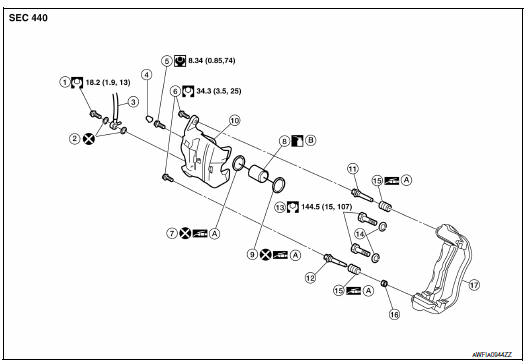
- Union bolt
- Copper sealing washer
- Brake hose
- Cap
- Bleed valve
- Sliding pin bolt
- Piston seal
- Piston
- Piston boot
- Cylinder body
- Upper sliding pin
- Lower sliding pin bolt
- Torque member bolt
- Washer
- Sliding pin boot
- Bushing
- Torque member
- Rubber grease
- Brake fluid
NOTE: Do not remove the torque member, pads, shims, shim covers, and anti-rattle clips when disassembling and assembling the cylinder body.
DISASSEMBLY
- Remove the sliding pin bolts, and then remove the cylinder body
from the torque member.
CAUTION: Do not drop pads, shims, shim cover and anti-rattle clips from torque member. - Remove the sliding pins, bushing and sliding pin boots from the torque member.
- Remove the cap and the bleed valve from the cylinder body.
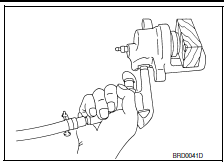
- Place a wooden block in the cylinder body and blow air through
the union bolt hole to push out the piston and piston boot as
shown. Discard the piston boot.
WARNING:
Do not get fingers caught between the piston and cylinder
body.
CAUTION: Do not reuse the piston boot.
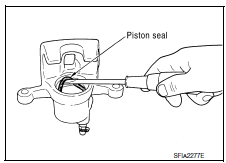
- Remove the piston seal from the cylinder body using a suitable tool as shown. Discard the piston seal.
CAUTION:
- Be careful not to damage the inner cylinder wall.
- Do not reuse the piston seal.
INSPECTION AFTER DISASSEMBLY
Cylinder Body
Check the inner cylinder wall for corrosion, wear, and damage. If a defect is detected, replace the cylinder body.
CAUTION: Clean the cylinder body using new brake fluid. Do not use mineral oils such as gasoline or kerosene.
Torque Member
Check the torque member for wear, cracks, and damage. If a defect is detected, replace the torque member.
Piston
Check the piston surface for corrosion, wear, and damage. If a defect is detected, replace the piston.
CAUTION: The piston sliding surface is plated. Do not polish the piston with sandpaper.
Sliding Pin, Sliding Pin Bolt, and Sliding Pin Boot
Check the sliding pin, sliding pin bolt, and sliding pin boot for wear, damage, and cracks. If a defect is detected, replace the components as necessary.
ASSEMBLY
- Apply rubber grease to the new piston seal, and install it in the cylinder body.
CAUTION: Do not reuse piston seal.
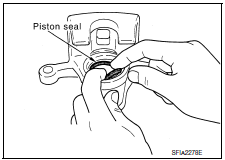
- Apply rubber grease to new piston boot and apply brake fluid to
the piston. Cover the piston end with the piston boot, and then
install the cylinder side lip on the piston boot securely into a
groove on the cylinder body.
CAUTION: Do not reuse piston boot.
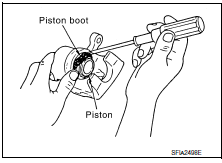
- Push the piston into the cylinder body by hand and push the piston
boot piston-side lip into the piston groove.
CAUTION: Press the piston evenly and vary the pressing point to prevent cylinder inner wall from being rubbed.
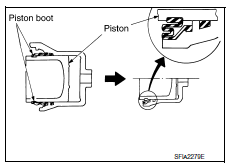
- Install the bleed valve and cap to the cylinder body.
- Install the sliding pins, bushing and sliding pin boots on the torque member.
- Install the cylinder body to the torque member, and then tighten the sliding pin bolts to the specified torque.
 Rear disc brake
Rear disc brake
Disassembly and Assembly
Union bolt
Brake hose
Copper sealing washer
Cap
Bleed valve
Lower sliding pin bolt
Upper sliding pin bolt
Bushing
Cylinder body
Piston seal
P ...
Other materials:
Center speaker
Description
The AV control unit sends audio signals to the BOSE speaker amp. The BOSE
speaker amp. amplifies the
audio signals before sending them to the center speaker using the audio signal
circuits.
Diagnosis Procedure
1.CONNECTOR CHECK
Check the AV control unit, BOSE speaker amp. and s ...
Intelligent Cruise Control (ICC) (if so equipped)
WARNING
Failure to follow the warnings and instructions
for proper use of the ICC system
could result in serious injury or death.
The ICC system is only an aid to assist
the driver and is not a collision warning
or avoidance device. It is the driver's
responsibility to stay alert, drive ...
Hydraulic line
Exploded View
High pressure hose
Suction hose
Reservoir tank bracket
Reservoir tank
Oil pump assembly
Steering gear assembly
Low pressure piping
Eye bolt
High pressure piping
Copper sealing washers
Eye bolt
Copper sealing washers
Power steering pressure sensor
...
Nissan Maxima Owners Manual
- Illustrated table of contents
- Safety-Seats, seat belts and supplemental restraint system
- Instruments and controls
- Pre-driving checks and adjustments
- Monitor, climate, audio, phone and voice recognition systems
- Starting and driving
- In case of emergency
- Appearance and care
- Do-it-yourself
- Maintenance and schedules
- Technical and consumer information
Nissan Maxima Service and Repair Manual
0.0074

